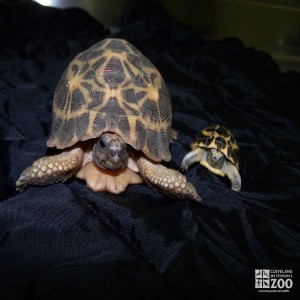Northern Spider Tortoise
[Pyxis arachnoides brygooi]

The spider tortoise is one of the smallest land tortoises with a shell length that reaches 6 inches. Its name comes from the yellow markings on its shell that resembles spider webs. Males are slightly smaller than females and have a longer thicker tail. This is a critically endangered species due to habitat loss. Spider tortoises spend time under vegetation to regulate their body temperature. They are most active during November to April when vegetation is plentiful.
Location: The Lower RainForest
Share:
Range
The spider tortoises range is the island of Madagascar.
Habitat
The spider tortoise inhabits tropical deciduous forests.
Conservation Status
Critically EndangeredPrimary Threats
Human Wildlife CoexistenceGestation
Tortoise eggs incubate for about 220 to 250 days before hatching
Litter
One egg is laid
Behavior
Spider tortoises are opportunistic browsers, stopping for an occasional bite to eat while moving from point to point. They do not hibernate, and they enjoy temperatures from the mid 50's to mid 80's, and an average humidity level of 77%. The tortoises require constant access to water for soaking. They are most active in the morning, shortly after sunrise, and then they seek out shade until late afternoon. They are found in the extreme southern portion of Madagascar.
Reproduction
When the wet season arrives and their dormancy period ends, Tortoise begin to look for a mate. Female spider tortoises only lay one egg per clutch, so populations cannot quickly recover from a decrease in numbers.
Wild Diet
Spider tortoises eat grasses, young leaves, rotos, insects and larve.
